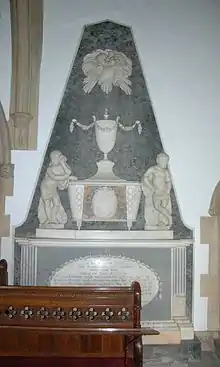
Monument in St Mary the Virgin parish church, Culworth, Northamptonshire to Sir John D'Anvers (died 1642) and his descendants, the five D'Anvers Baronets of Culworth
There have been two baronetcies created for persons with the surname Danvers, one in the Baronetage of England and one in the Baronetage of Great Britain. Both creations are extinct.
.svg.png.webp)
Arms of the Danvers baronets of Culworth (Danvers ancient): Gules, a chevron between three mullets of six points pierced or
The D'Anvers Baronetcy, of Culworth in the County of Northampton, was created in the Baronetage of England on 21 March 1643 for Samuel D'Anvers. The title became extinct on the death of the fifth Baronet, Sir Michael D'Anvers, in 1776.
The Danvers Baronetcy, of Swithland in the County of Leicester,[3] was created in the Baronetage of Great Britain on 4 July 1746 for Joseph Danvers, Member of Parliament for Boroughbridge, Bramber and Totnes. The title became extinct on the death of the second Baronet in 1796.
Danvers baronets, of Culworth (1643)
- Sir Samuel Danvers, 1st Baronet (1611–1682)
- Sir Pope Danvers, 2nd Baronet (1644–1712)
- Sir John Danvers, 3rd Baronet (1673–1744)
- Sir Henry D'Anvers, 4th Baronet (1731–1753)
- Sir Michael D'Anvers, 5th Baronet (1738–1776)
Danvers baronets, of Swithland (1746)
- Sir Joseph Danvers, 1st Baronet (1686–1753)
- Sir John Danvers, 2nd Baronet (c. 1722–1796)
References
- ↑ Burke, J.; Burke, B. (1844). A Genealogical and Heraldic History of the Extinct and Dormant Baronetcies of England, Ireland, and Scotland. W. Clowes. p. 152.
- ↑ MacNamara, F.N., Memorials of the Danvers Family, London, 1895
- ↑ "No. 8549". The London Gazette. 1 July 1746. p. 3.
This article is issued from Wikipedia. The text is licensed under Creative Commons - Attribution - Sharealike. Additional terms may apply for the media files.
